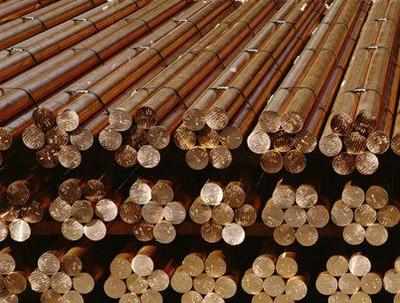- News
- Science News
- Copper and its alloys destroy 'stomach flu' virus
This story is from June 8, 2015
Copper and its alloys destroy 'stomach flu' virus
Metal surfaces containing copper can destroy human norovirus, one of the causes of gastroenteritis or ‘stomach flu’, a new study has found.

Metal surfaces containing copper can destroy human norovirus, one of the causes of gastroenteritis or ‘stomach flu’, a new study has found.
NEW DELHI: Metal surfaces containing copper can destroy human norovirus, one of the causes of gastroenteritis or ‘stomach flu’, a new study has found. Copper vessels or utensils made from brass and bronze and even doorknobs or handrails with such surfaces could help kill off the virus which is a global scourge. The study was published online in Applied and Environmental Microbiology, a journal of the American Society for Microbiology.
"Human norovirus is an unusually infectious microbe that causes stomach flu, including copious vomiting and diarrhea. It is a major problem on cruise ships, in restaurants, and in elder care homes, where the disease is easily transmitted by environmental contamination," said Clyde Manuel, a doctoral student of North Carolina State University, Raleigh. "This is the first study to demonstrate copper's destructive powers against human norovirus," said Manuel.
Several earlier studies have established that copper is very effective against a host of bacteria that cause a variety of human diseases including stomach ailments, pneumonia, meningitis, skin infections etc. But this is the first study to record copper’s action against a virus.
In the study, the authors obtained five different copper alloys, and stainless steel as a control surface, cutting these into coupon-sized pieces. "We deposited either human fecal samples containing infectious virus, or virus-like particles onto each coupon, and then tested survival of virus at various time points," said Manuel. (Virus-like particles are the shells of viruses, which have the same surface properties as infectious virus, and which are easier to grow than complete viruses.) The results: "A variety of copper surfaces had a major impact on the virus, whereas the virus was very stable on stainless steel surfaces."
Specifically, the copper surfaces destroyed both the virus' genome, and its capsid, or protein shell. "Perhaps these copper surfaces can be used on high touch surfaces, like door knobs, hand rails, and so forth, to prevent environmental transmission of the virus," said Manuel. He notes that a hospital intensive care unit that recently replaced other materials in high touch surfaces with copper reduced the overall infection rate by half.
The cycle of virus destruction begins when copper ions generate free radicals from water and oxygen, and sometimes from certain sulfur-containing amino acids. Free radicals react energetically with molecules such as DNA and proteins, damaging and often destroying them.
Many ancient societies used utensils made of copper or its alloys for food and water. These included ancient India, Greece, Rome and the Aztecs. In modern times, copper use in kitchens and food keeping has fallen as stainless steel or even synthetic materials have become available.
"Human norovirus is an unusually infectious microbe that causes stomach flu, including copious vomiting and diarrhea. It is a major problem on cruise ships, in restaurants, and in elder care homes, where the disease is easily transmitted by environmental contamination," said Clyde Manuel, a doctoral student of North Carolina State University, Raleigh. "This is the first study to demonstrate copper's destructive powers against human norovirus," said Manuel.
Several earlier studies have established that copper is very effective against a host of bacteria that cause a variety of human diseases including stomach ailments, pneumonia, meningitis, skin infections etc. But this is the first study to record copper’s action against a virus.
In the study, the authors obtained five different copper alloys, and stainless steel as a control surface, cutting these into coupon-sized pieces. "We deposited either human fecal samples containing infectious virus, or virus-like particles onto each coupon, and then tested survival of virus at various time points," said Manuel. (Virus-like particles are the shells of viruses, which have the same surface properties as infectious virus, and which are easier to grow than complete viruses.) The results: "A variety of copper surfaces had a major impact on the virus, whereas the virus was very stable on stainless steel surfaces."
The copper acted quickly. Ten minutes' exposure was sufficient to virtually abolish the receptor-binding ability of human norovirus virus-like particles, an effect that was not observed on the stainless steel surfaces.
Specifically, the copper surfaces destroyed both the virus' genome, and its capsid, or protein shell. "Perhaps these copper surfaces can be used on high touch surfaces, like door knobs, hand rails, and so forth, to prevent environmental transmission of the virus," said Manuel. He notes that a hospital intensive care unit that recently replaced other materials in high touch surfaces with copper reduced the overall infection rate by half.
The cycle of virus destruction begins when copper ions generate free radicals from water and oxygen, and sometimes from certain sulfur-containing amino acids. Free radicals react energetically with molecules such as DNA and proteins, damaging and often destroying them.
Many ancient societies used utensils made of copper or its alloys for food and water. These included ancient India, Greece, Rome and the Aztecs. In modern times, copper use in kitchens and food keeping has fallen as stainless steel or even synthetic materials have become available.
End of Article
FOLLOW US ON SOCIAL MEDIA
